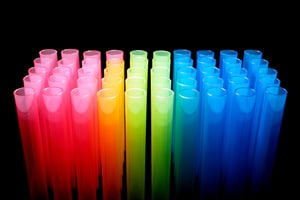 Aside from its significant role in the natural world, fluorescence is also hard at work in biotechnology and the life sciences. In fact, fluorescent dyes are being widely used in numerous applications such as flow cytometry, immunofluorescence, Western blotting, and DNA electrophoresis. Just how important are these dyes and how do you choose one that best suits your application? Here are some things you need to know to help you make the right decision.
Aside from its significant role in the natural world, fluorescence is also hard at work in biotechnology and the life sciences. In fact, fluorescent dyes are being widely used in numerous applications such as flow cytometry, immunofluorescence, Western blotting, and DNA electrophoresis. Just how important are these dyes and how do you choose one that best suits your application? Here are some things you need to know to help you make the right decision.
Fluorescent Dyes: Getting to Know the Basics
What exactly are fluorescent dyes and how do they work? Basically, fluorescent dyes are natural or synthetic compounds that absorb light or electromagnetic energy and re-emit it at a lower energy (i.e., longer wavelength) in the form of a photon.
Despite the sheer number of fluorophores available for use in the lab, these dyes usually fall into one of these three groups:
- Fluorescent dyes. These are small, organic natural or synthetic fluorescent molecules used in labeling biologically relevant molecules in in vitro Some of the fluorescent dyes in this group include fluorescein, ethidium bromide, and cyanine.
- Fluorescent proteins. These are larger, biologically manufactured proteins that fluoresce as a result of their macromolecular structure. GFP, RFP, and YFP are some of the dyes that belong to this group.
- Quantum dots. These highly fluorescent synthetic nanocrystals are made from semiconductor materials.
With the extensive application of the basic properties of fluorescence and the significant advancement in this field, hundreds of reactive fluorescent dyes have already been developed and optimized for specific applications and instrumentations. Likewise, a huge number of complex fluorescence technologies (e.g., FRET, TRF, FP, FRAP, FACS, FCS) have evolved through the years.
Why Use Fluorescent Dyes?
While different staining techniques (i.e., Coomassie stains, silver stains, fluorescent stains) can be used for visualizing proteins separated by gel electrophoresis, using fluorescent dyes has its own unique advantages. They offer:
- High sensitivity. Fluorescence measurements can be 1000x more sensitive than absorbance measurements and can satisfactorily achieve up to ppt (parts per trillion) detection limits for most analytes, even when using small sample sizes.
- Wide linear dynamic range. The output is directly proportional to the sample concentration.
- Low interference. Spectrophotometric measurements usually encounter interference problems due to the large number of materials that absorb light. You won’t run into this problem when doing fluorimetric measurements since only a few materials have the ability to fluoresce.
- High throughput. Fluorimetric measurements have a simple yet robust protocol and can be automated for high throughput applications.
How Do You Choose Your Dye?
Considering the wide variety of fluorescent stains, how do you choose which dye to use for your particular application? Here are some factors you need to consider.
- Compatibility with the design of the experiment. While they may share some spectral similarities with other fluorophores, each dye is unique and have different functionality, excitation and emission wavelength, band shape and width, and photostability. To ensure success, choose one that complements the design of your experiment.
- Compatibility with the equipment. Choose a dye that matches the illumination source you are using. In choosing an appropriate fluorescence instrument, consider the instrument’s sensitivity, dynamic range, stability and throughput, signal-to-noise and signal-to-blank ratios. For even better results, make sure the emission profile of the dye matches the available detection methods.
- Compatibility with other fluorescent materials in the sample. In double or triple labeling experiments, the emission and excitation profile of your chosen dye should not overlap with the other fluorophores. Since many naturally occurring cell components will fluoresce at the same wavelength as your chosen dye or probe, you also need to make sure that you can clearly identify the signal produced by your chosen dye from background autofluorescence.






